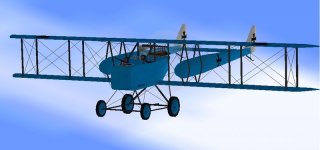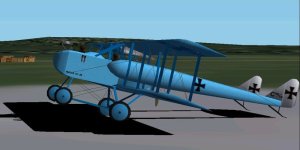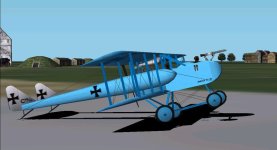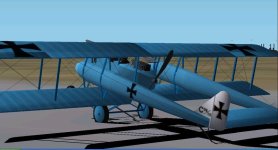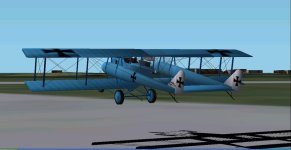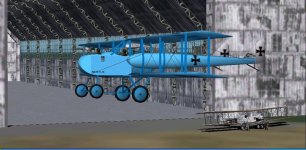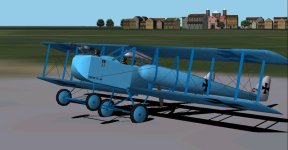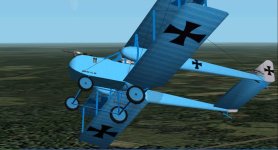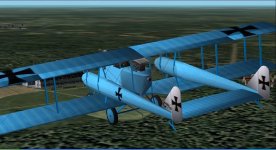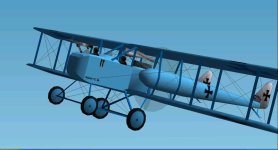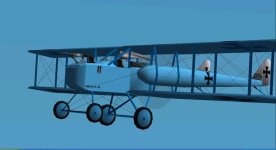Hello Folks,
This thread, originally intended for four rather peculiar Russian oberver/bomber biplane designs with twin fuselages or tailbooms, has now extended its scope to cover another peculiar twin-tailboom design, the German AGO C.I observer. I hope this mere nationality issue does not make the AGO off topic!
Initially, my intention was to upload only the AGO C.I model for CFS2, but in view of the interest it has awakened amongst simmers, I am currently converting it into a C.II observer/bomber using the necessary parts from the FS98 AGO C.II model I built in 2008. (It is easier to do it this way than to upgrade the 2008 C.II model, as for some reason, I hadn´t hollowed it out like the C.I).
The screenshot shows the blue FS98 livery. It is only approximate in the colour-hue, and I hope to be able to pale it down with the extended textures allowed in CFS2, to make the livery more accurate. Also, the crew and gun will be substituted by the ones in the Dp files, and some bombs will be hung from the nose sill.
Expounding on my last post on the later development of the AGO C.I, before the C.II came out, a C.I variant was built, equipped the same Class III motorization. It was structurally strengthened, presumably because the design was intended to carry bombs, and was thus 1078 lb heavier, which lowered top speed by 5 kt (6 mph).
Wingspan was 1 ft. 7 in. shorter, length was 7 ft. 3 in.longer, and it had a higher, triangular fin/rudder. Also, the lateral radiators were substituted by a more efficient larger, slanted, winged radiator above the engine.
However, engine performance was insufficient for a greater payload, and this model was also only used for reconnaissance. It is shown in a pale yellow livery by some sources, and also with clear-doped wings and dark yellow or varnished wood,light brown tailbooms with white triangular fin/rudders. The production run seems to have been similar to that of the original G.I.
Later, after successful trials with a more powerful motorization, Mercedes D.IV or Benz Bz.IV, rated for combat at 235Hp and 230Hp respectively, the aircraft was able to carry bombs, and was able to retain the remarkable performance of the C.I. At that point, designation was changed to AGO C.II, and 15 units were built.
Altogether, it seems that there were a total of 64 units of the AGO C Series in service on the Western front from 1915 to 1917.
An important update: I finally found what I was looking for, for weeks now, as to the AGO C.II´s bomb capacity.
A Polish site states that it was 50 kg, which would mean 4 x 12.5 Kg bombs. (110 lb, 4 x 27.5 lb)
It seems they were hung on the outside, and dropped by hand. There is no reference to bombing altitude,
but I would guess that perhaps they did it from around 2000 ft, out of reach from rifle fire.
...Or maybe they risked it from 1000 ft, for greater accuracy?
This could be done on the CFS2 model simply by opening a new Top-Down view window, enlargening it with
the mouse to fit half the screen, and dropping the bombs by dead reckoning, eye-balling.
There was no bombsight fitted.
Cheers,
Aleatorylamp


 Anyone out there with knowledge about it to make a historic mission?
Anyone out there with knowledge about it to make a historic mission?

